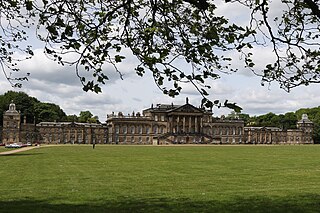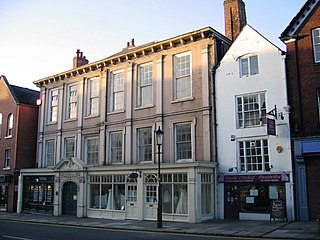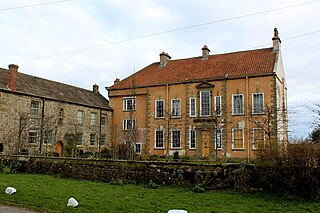
Wentworth Woodhouse is a Grade I listed country house in the village of Wentworth, in the Metropolitan Borough of Rotherham in South Yorkshire, England. It is currently owned by the Wentworth Woodhouse Preservation Trust. The building has more than 300 rooms, with 250,000 square feet (23,000 m2) of floorspace, including 124,600 square feet (11,580 m2) of living area, and was – until it ceased to be privately owned – often listed as the largest private residence in the United Kingdom. It covers an area of more than 2.5 acres (1.0 ha), and is surrounded by a 180-acre (73 ha) park, and an estate of 15,000 acres (6,100 ha).

Bretton Hall is a country house in West Bretton near Wakefield, West Yorkshire, England. It housed Bretton Hall College from 1949 until 2001 and was a campus of the University of Leeds (2001–2007). It is a Grade II* listed building.

Lyme Park is a large estate south of Disley, Cheshire, England, managed by the National Trust and consisting of a mansion house surrounded by formal gardens and a deer park in the Peak District National Park. The house is the largest in Cheshire, and is recorded in the National Heritage List for England as a designated Grade I listed building.

Tabley House is an English country house in Tabley Inferior, some 3 kilometres (1.9 mi) to the west of the town of Knutsford, Cheshire. The house is recorded in the National Heritage List for England as a designated Grade I listed building. It was built between 1761 and 1769 for Sir Peter Byrne Leicester, to replace the nearby Tabley Old Hall, and was designed by John Carr. The Tabley House Collection exists as an exhibition showcased by the University of Manchester.

John Carr (1723–1807) was a prolific English architect, best known for Buxton Crescent in Derbyshire and Harewood House in West Yorkshire. Much of his work was in the Palladian style. In his day he was considered to be the leading architect in the north of England.
Gilling Castle is a Grade I listed country house near Gilling East, North Yorkshire, England.

Carr Manor is a Victorian grade II listed house in Meanwood, Leeds, England, designed by Edward Schroeder Prior and built for Thomas Clifford Allbutt (1836–1925). In 1881 it replaced Carr Manor House, though retaining the 1796 stable block. The former gardener's and housekeeper's cottages, the former stables and the wall, gate piers and gates are also grade II listed.

Lytham Hall is an 18th-century Georgian country house in Lytham, Lancashire, 1 mile (1.6 km) from the centre of the town, in 78 acres (32 ha) of wooded parkland. It is recorded in the National Heritage List for England as a designated Grade I listed building, the only one in the Borough of Fylde.

Cowling is a village, electoral division and civil parish in the Craven district of North Yorkshire, England. It is situated on the borders with the adjacent counties of West Yorkshire, and Lancashire.

Oddfellows' Hall, originally Bridge House is at 16–24 Lower Bridge Street, Chester, Cheshire, England. It is recorded in the National Heritage List for England as a designated Grade II* listed building.

Grimethorpe Hall is a manor house in Grimethorpe, South Yorkshire, England. Built circa 1670 for Robert Seaton, it is thought to be in the style of York architect Robert Trollope. Around 1800 the hall passed to John Farrar Crookes of Tunbridge Wells. It was last used as a house in the 1960s and afterwards was purchased by the National Coal Board. The National Coal Board applied to demolish it in 1981 but, after a campaign by the Ancient Monuments Society, this was unsuccessful. The structure received statutory protection as a grade II* listed building in 1985.

Newton Kyme Hall is a historic building in the village of Newton Kyme, north-west of Tadcaster in North Yorkshire, in England.
Aislaby Hall is a historic building in the village of Aislaby, near Pickering, North Yorkshire, in England.

Cowling Hall is a historic building in Cowling, a village near Bedale in North Yorkshire, in England.

Byram Park is a former country estate in Byram, North Yorkshire, a village in England.

Yew Tree House is a historic building in Cawood, a village in North Yorkshire, in England.
Ingleborough Hall is a historic building in Clapham, North Yorkshire, a village in England.

Turnham Hall is a historic building in Cliffe, a village near Selby in North Yorkshire, in England.

Crakehall Hall is a historic building in Crakehall, a village in North Yorkshire, in England.
Lazenby Hall is a historic building near Danby Wiske, a village in North Yorkshire, in England.
















